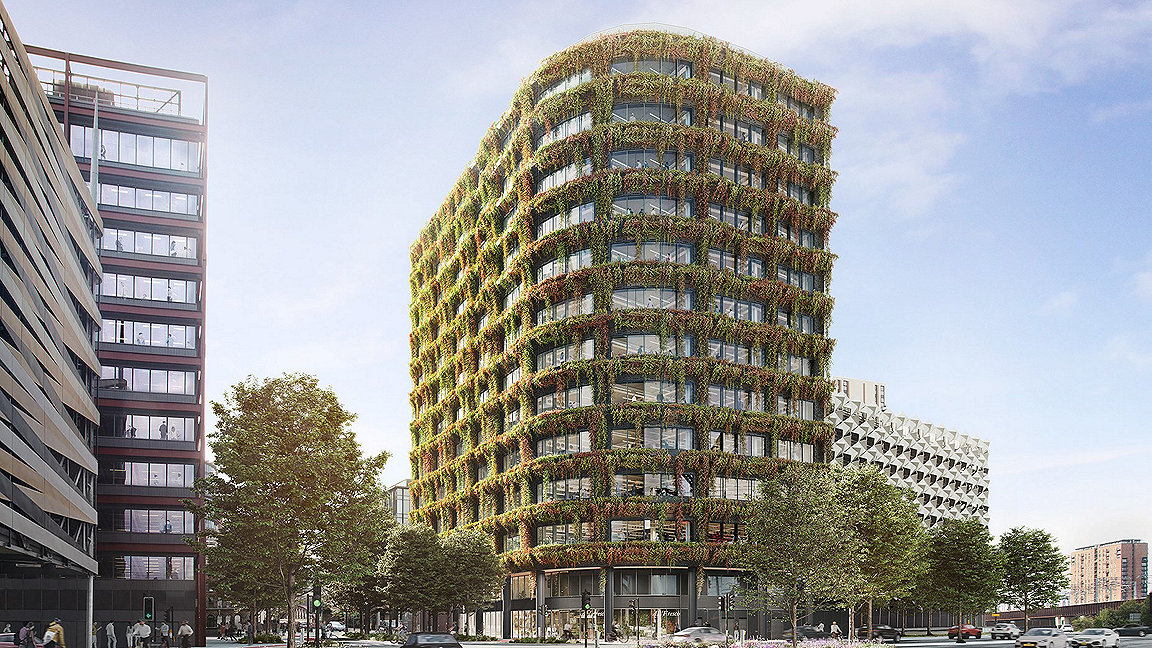
English Cities Fund's New Bailey, Salford Central scheme is targeting net zero carbon in operation © Make
COP26 was always going to be a significant milestone in the global fight against climate change. The Glasgow conference aimed to review the Paris Agreement of 2015, which committed to keep global warming well below 2C, with an ambition of 1.5C.
Since the UK is already committed to net zero by 2050, the pressure on industries – particularly high emitters such as construction – has been increasing exponentially. With the government's interim target of 78% reductions by 2030 aligning with the 1.5C Paris trajectory, it is now clearer than ever that we must act.
However, while the commitment is there, the UK does not yet have the legislation or policy to support it. At times this makes progress toward net zero painfully slow. But even without legislation guiding the way, the built environment can do much more than it is currently doing to achieve net zero.
Industry takes the initiative
The UK's Committee on Climate Change has recommended reductions for new and existing assets alike. Yet we are already seeing the industry prepared to go much further.
Many local authorities have set dates earlier than 2050 for achieving net zero. Developers are therefore signing up to initiatives such as the Better Buildings Partnership (BBP) Climate Commitment and the World Green Building Council's (WGBC) Net Zero Carbon Buildings Commitment. Together, these set the minimum standard for developers that are serious about achieving net zero carbon.
The BBP commitment is one of the most ambitious that developers can adopt. Signatories must publish their net-zero carbon pathways and implementation plans and disclose the energy performance of their assets. They also have to develop comprehensive climate resilience strategies.
Meanwhile, signatories to the WGBC commitment declare that the buildings they control will be net zero by 2030. This encourages an aggressive global push towards energy efficiency, and a shift from fossil fuel to renewables. It also includes requirements to reduce embodied carbon emissions.
This leaves little space for developers to hide. Most recognise that it is not sufficient to be carbon-neutral by offsetting their footprint. Instead, they want to set targets that require absolute reductions in carbon in line with the latest climate science. Only then will they look to offset.
Financial frameworks help reduce carbon
Finance is also having an influence, and major investors are increasingly vocal about what they expect. There is now increasing pressure on pension and hedge funds to meet more stringent environmental, social and governance (ESG) criteria, including net-zero carbon and climate resilience.
Several frameworks and reporting processes have also sprung up over the past few years to help businesses. One is Science-Based Targets (SBT), a global initiative including environmental charities CDP and WWF as well as the World Resources Institute (WRI). It encourages businesses to set carbon reduction targets in line with the latest climate science.
SBT has recently published a net-zero carbon blueprint for businesses. This makes clear that organisations will be required to take responsibility not for just the impacts of their own operations but also their supply chain's emissions.
The investment community may not realise it yet, but pushing such targets will effectively force developers and contractors to measure and lower embodied carbon, in line with climate science. That means a reduction of at least 50% for all buildings by 2030.
Meanwhile, the Task Force on Climate-related Financial Disclosures (TCFD), which was created in 2015 by the international Financial Stability Board (FSB), aims to improve climate-related financial reporting. It has encouraged a considerable rise in reporting over the past year. This increases pressure on developers to prioritise net-zero carbon for new and existing buildings.
Assets and portfolios that do not act run the risk of losing value. As decarbonisation requirements increase over time to align with Paris and net-zero-carbon trajectories, assets that overshoot are vulnerable to financial penalties, devaluation and funding problems.
Expectations for legislation
This still leaves legislation. In October, the government published its Heat and Buildings Strategy, setting out how the UK will decarbonise its building stock. Although it is a good start, however, the document lacks detail. The parliamentary Environmental Audit Committee is meanwhile conducting an inquiry on the sustainability of the built environment. This is reviewing the role of the built environment in meeting net-zero carbon commitments. But it needs to act decisively to put all necessary requirements in place in the next year.
The RIBA 2021 ethics and sustainable survey found that these should include: mandatory upfront and whole-life embodied carbon assessments for all new and major refurbishment work; mandatory public disclosure of operational energy performance of all buildings, with sliding minimum targets to 2050; a ban on new gas boilers for all buildings; plus subsidised insulation and energy efficiency works for existing homes and public buildings.
There is also a call to level VAT on new and existing buildings, because it's currently cheaper to knock down and rebuild than it is to retrofit. Some even argue that there should be no VAT on retrofit and full VAT for new builds.
Most importantly, the industry has the will to change.
COP26 can be the springboard for the industry to meaningful action to meet our commitments and limit global temperature rises to 1.5C.
